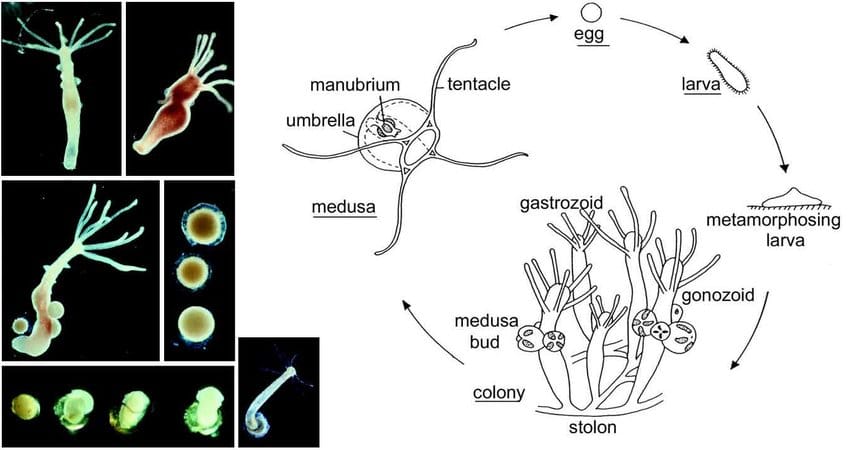What is a Hydra?
Hydra is a multi-cellular freshwater animal. Unlike unicellular animals or protozoans such as Amoeba and paramecium, multi-cellular animals are built up of many cells and are known collectively as metazoans.
Coelenterates are the simplest metazoans and Hydra belongs to this group.
Hydra Habitat
Hydra is a freshwater animal commonly found in ponds and streams in Europe, Africa, and Asia, but more commonly in the west indies.
Characteristics of Hydra
Hydra belongs to a group of animals known as polyps and is the smallest polyp known, reaching a maximum length of 12 mm.
Hydra is an invertebrate with a tiny, translucent tubes and tentacles that measure about 1 inch and feed on smaller aquatic animals.
It is a coelenterate and possesses the characteristic feature of all animals included in this group – one body cavity with one opening for communication with the exterior.
There are various species of Hydra which can be colorless, brown, or green.
Hydra Reproduction
The reproductive organs of hydra are of two types, male testes, and female ovaries.
Testes occur in the upper part of the body while ovaries arise from the basal region.
Each testis is a spherical protuberance lined by a layer of ectoderm. It contains masses of small cells with large, prominent nuclei.
These cells are in all stages of development, the final products being small motile male gametes called spermatozoan or sperms.
Like the testes, each ovary, when ripe, they’re spherical, however, it contains larger cells with denser, yolky ectoplasm, and less prominent nuclei. These cells are known as ova.
Only one ovum, also known as the egg cell, or ectocyte of a ripe ovary hangs freely in the water suspended from the parent by a thin layer of gelatinous material that also surrounds it.
Hydra Mode of Life
The mode of life of Hydra is more diversified than most other organisms.
The mesogloea can be taken to represent a primitive skeleton. It also shows a primitive nervous and muscular system.
The body is differentiated into a complex body wall and a body cavity.
Hydra is very flexible, that is, its body can extend to form a long slender tuber, can bend in any direction, and can contract to a short spherical blob.
The contraction and extension of the body are controlled by the muscle tails of both the ectodermal and endodermal musculo-epithelial cells.
When the ectodermal muscle tails contract, the body contracts also, that is it becomes shorter and fatter.
The reverse happens when the endodermal muscle tails contract- the body extends, that is, it becomes longer and narrower.
Feeding in Hydra
Hydra feeds mainly on small water animals, especially minute crustaceans such as water fleas.
When a swimming animal touches its tentacles, the nematocyst threads are discharged immediately.
Some of these threads inject a poisonous paralyzing fluid into the prey while others hold on to the prey by coiling around its bristles or adhering to its body surface.
The tentacles then contract and bend inwards, carrying the food towards the mouth which opens wide to receive it.
Gland cells in the endoderm become active and secrete digestive enzymes into the enteron.
These kill the prey and begin its digestion. the partially digested food is usually ingested by the digestive cells in which digestion is completed. Thus, hydra shows both extracellular and intracellular digestion.
The digested food diffuses to all parts of the body. the hard indigestible portions are sent out through the mouth which also functions as the anus.
Respiration in Hydra
Hydra respires by taking in oxygen from the surrounding water and giving out carbon dioxide.
The gaseous change takes place by means of diffusion. Since both the ectoderm and endoderm are normally bathed in water, no cell is usually too far from its water source.
Regeneration in Hydra
Hydra can replace lost parts of its body such as tentacles by a process called regeneration.
If the body is cut into two parts, each part can grow into a complete animal.
Even parts of the hypostome and tentacles can form new individuals.








